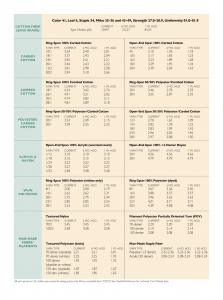 By Jim Phillips, Yarn Market Editor
By Jim Phillips, Yarn Market Editor
The U.S. textile industry continues to make considerable strides in sustainable manufacturing.
For example, American & Efird — and its subsequent parent company, Elevate Textiles — has been establishing sustainability goals and publishing reports quantifying how it is achieving those standards for more than half a decade. Unifi, with its REPREVE® line of products, has also taken its place among the global leaders in environmentally friendly manufacturing methods and technology. Glen Raven published its first sustainability report in 2021. And more and more companies are joining the ranks.
“Many in the textile arena — the fiber producers, the yarn makers, the weavers, knitters, dyers and finishers — have achieved some remarkable results in what could be considered a relatively short period of time,” said one university ecology professor. “You used to think of textiles as a ‘dirty’ industry, one that left the air and water polluted. It was not uncommon at all to see once-beautiful rivers near a dyehouse be a different color every day, with no life-sustaining properties. You don’t see that today. Certainly, a bit of that is attributable to regulation, but much of it has been because of the efforts of environmentally responsible companies. Some other industries are following this lead, and, unfortunately, some are still lagging behind.”
U.S. Cotton Trust Approved As International Sustainability Standard
In addition to individual companies, entire segments of the industry are also making considerable headway in sustainability endeavors.
For example, The U.S. Cotton Trust Protocol has been approved as a standard for sustainable cotton by Siegelklarheit, an initiative of the German Federal Government. By helping consumers to better understand environmental and social labels, Siegelklarheit wants to contribute to more sustainable purchasing decisions. U.S. Cotton Trust Protocol successfully passed Siegelklarheit´s assessment system. As a result, members of the Partnership for Sustainable Textiles (PST) can use the Trust Protocol as another standard to calculate their share of sustainable cotton.
The Trust Protocol is the only system that provides quantifiable, verifiable goals and measurement and drives continuous improvement in six key sustainability metrics — land use, soil carbon, water management, soil loss, greenhouse gas emissions, and energy efficiency. It is also the world’s first sustainable cotton fiber system to offer its members article-level supply chain transparency through the Protocol Consumption Management Solution.
“The Trust Protocol’s vision is to set a new standard in sustainable cotton production where full transparency is a reality and continuous improvement to reduce our environmental footprint is the central goal,” said Dr. Gary Adams, president of the U.S. Cotton Trust Protocol. “We commit to ensuring the protection and preservation of the planet, using the most sustainable and responsible techniques.”
Launched in 2020, the U.S. Cotton Trust Protocol was designed to set a new standard in more sustainably grown cotton, ensuring that it contributes to the protection and preservation of the planet, using the most sustainable and responsible techniques.
U.S./Australian Consortium Successfully Diverts Cotton Waste
A 12-month trial on a cotton farm just outside the rural town of Goondiwindi, Queensland, Australia, has shown it is possible to divert large amounts of cotton textile waste at end of life from landfills to cotton fields with no harm done to soil health or cotton yields, according to Cotton Leads, a consortium of the U.S. and Australian cotton industries. Project collaborators are confident that with a solid business plan and more research, returning shredded cotton products to cotton fields could soon offer benefits to soil health, as well as a scalable solution to the massive global problem of textile waste.
“At the very least the trial showed that no harm was done to soil health, with microbial activity slightly increased and at least 2,070kg of Carbon Dioxide equivalents (CO2e) mitigated through the breakdown of these garments in soil rather than landfill,” said Dr. Oliver Knox, cotton-industry-supported soil scientist said. “The trial diverted around two tons of textile waste from landfills with no negative impact on cotton planting, emergence, growth or harvest. Soil carbon levels remained stable, and the soil’s bugs responded well to the added cotton material.”
He continued: “There also appeared to be no adverse effect from dyes and finishes, although more testing is needed on a wider range of chemicals to be absolutely sure of that.”
According to a farmer involved in the testing, the cotton fields easily “swallowed up” the shredded cotton material, giving him confidence that this composting method has practical long-term potential. “We spread the cotton textile waste a few months before cotton planting in June 2021 and by January and the middle of the season the cotton waste had all but disappeared, even at the rate of 50 tons to the hectare,” he said.
July 2022





